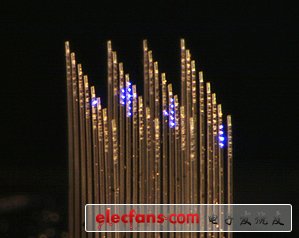The precise control of neurons with light can revolutionize the research of brain science and the treatment of brain diseases.
Optogenetics combines light-sensitive genes and light sources to selectively turn the brain on or off. Optogenetics has become a promising research tool and potential therapy. However, most of the time, this technique only hits light at a certain point, and brain activity often involves different regions being activated in a complex sequence. A new device can turn optogenetics into a three-dimensional technology, sending patterns of light to neurons at different coordinates in the brain.
"In the next few years, a large number of similar devices will appear," said Ilker Ozden, research assistant professor at the Nanophotonics and Neuroengineering Laboratory at Brown University. Ozden was not involved in this research, but was one of several researchers who developed similar technologies.
Ed Boyden, the corresponding author of the paper, said: "The brain is a 3D thing." Boyden is also the director of the SyntheTIc Biology Group at the MIT Media Lab.
So far, most optogenetics studies have used only one or two fibers to open or close a small piece of brain tissue. Many laboratories are looking for ways to increase the level of control. Boyden said that using a beam of light is like playing with a note, and the 3D detector makes it possible to "manipulate the brain like playing a piano."

Light control: This optical micrograph shows a three-dimensional array of light probes, which can be illuminated with lasers and micromirrors in any mode.
This optical genetic device can activate brain cells in a set pattern.
Two years ago, Boyden's team collaborated with MIT's Clifton Fonstad laboratory to invent the linear optogenetic detector. This detector has many parallel channels called waveguides, which can direct light to any one of the different points that the detector points to.
The new equipment was published in OpTIcs Letters. It also has a transplantable, finely made part on its tip that can glow at different depths. Boyden ’s team used a laser light source and a series of tiny mirrors (which can direct light to or away from the waveguide) to create patterns of time and space. At the same time, the microlens can direct the light passing through the waveguide to the brain. A mirror at the end of the waveguide can send light into the cell.
Although the paper does not show the application of the device in the brain, Boyden said his team is implanting the device in the brain of living mice and activating neurons according to the pattern.
"With the 3D array, we can do many things that we couldn't do before," Boyden said. For example, the technique can be used to systematically pinpoint specific areas of cells that produce a certain behavior, or generate random patterns and study their effects.
It can also create a more controlled and flexible neuroprosthesis based on optogenetics. Ozden said that such neural prosthesis must produce different stimulation patterns for different brain regions to be effective. Boyden said another long-term goal is to understand the specific sequence of brain activity when the disease worsens or the brain responds to therapy.
Lithium battery charger is a device used to recharge lithium-ion batteries, which are commonly found in electronic devices such as smartphones, laptops, cameras, etc. These Li-ion chargers are specifically designed to safely and efficiently recharge lithium batteries, which have become the preferred choice for many consumers due to their high energy density and long-lasting performance.
8.4v1a 8.4v1.5a 8.4v2a 12.6v1a 12.6v1.2a 16.8v1a 14.6v1a li ion charger sells very well, especially 3s li-ion charger. You can also choose led indicator light for lithium charger. Red light means charging and green light means fully charged.
When using a lithium battery charger, it is important to follow the manufacturer's instructions to ensure proper charging and to prevent any potential safety hazards. Overcharging a lithium battery can cause it to overheat, swell, or even catch fire, so it is crucial to use a charger that is compatible with the specific type of lithium battery being charged and to never leave the battery unattended while charging.
Overall, a lithium battery charger is an essential accessory for anyone who uses devices powered by lithium-ion batteries. By investing in a quality charger and following proper charging practices, users can extend the lifespan of their batteries and ensure that their devices are always ready for use.
lithium battery charger, 12.6v battery charger, 8.4v battery charger, 16.8v battery charger, 14.6v battery charger
Guangdong Mingxin Power Technologies Co.,Ltd. , https://www.mxpowersupply.com